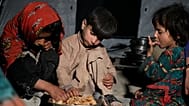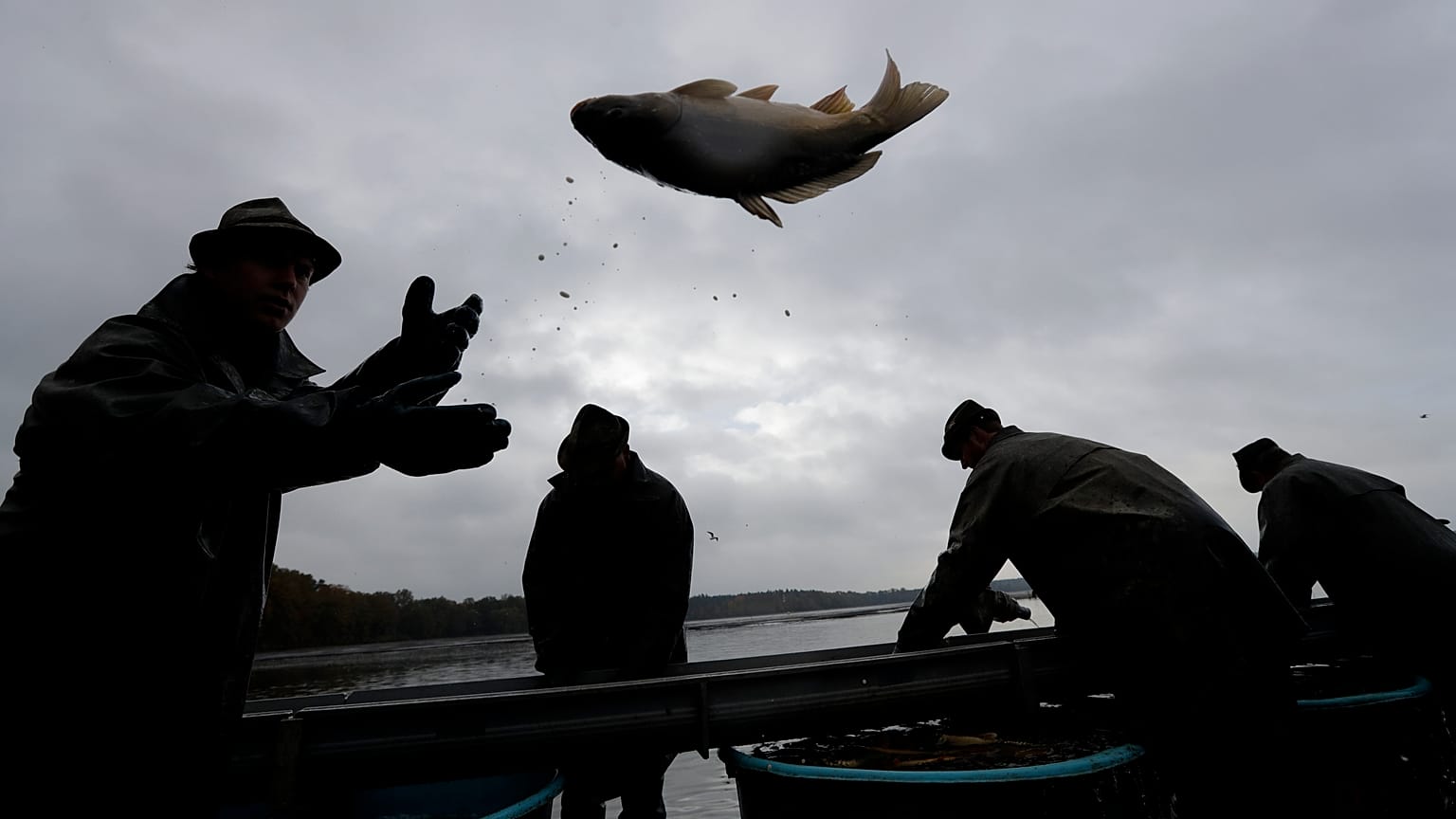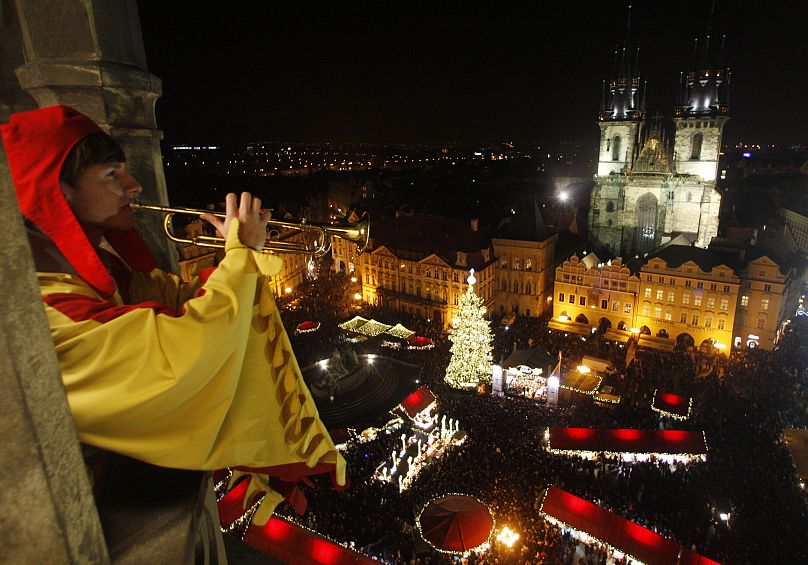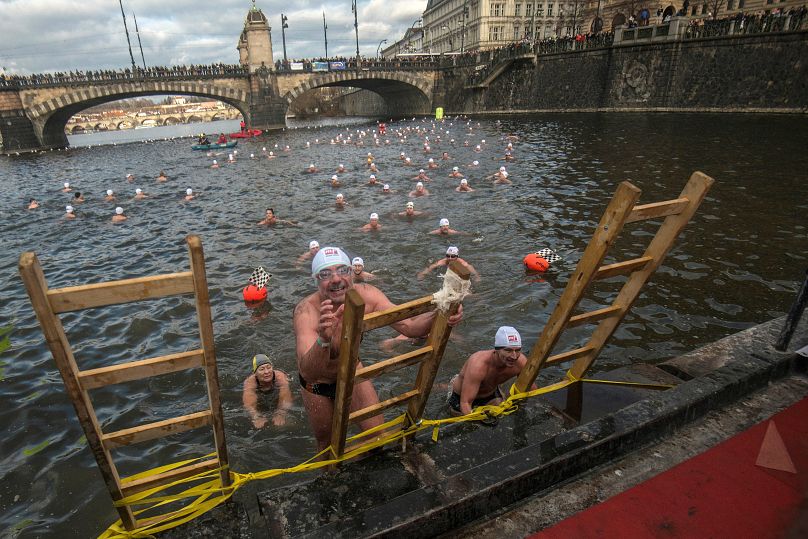Rather than an Anglo-Saxon turkey, some Czechs prefer carp, traditionally fried in bread crumbs and served with potato salad.
Picture the Czech idyll. It’s the evening of 24 December, and one’s immediate family are sitting down to the Christmas Eve meal, the highlight of the festive season.
In the days beforehand, you would have visited one of the thousands of carp sellers that line the streets of the country.
For the traditionally minded, you would have bought your carp alive and kept it in the bathtub until 24 December.
For the more squeamish, the carp seller would kill and skin it for you.
What are the Czech Christmas traditions?
Despite December 24 being known as “generous day” (Štědrý den), many Czechs still fast until the evening meal. If they do, children are told to look out for a golden pig (zlaté prase), a sign of good luck for the next year.
After dinner, the family takes turns cutting open an apple. If the core shows a star, it means there will be a birth next year; a cross signifies a death.
Then comes the presents. But instead of being brought by a red-garbed Santa Claus or a variant of Saint Nicolas, Czech children eagerly await their gifts delivered by Baby Jesus (Ježíšek).
For some families, the Baby Jesus also brings the Christmas tree, which is erected by parents on the evening of 24 December.
After the familial jovialities of Christmas Eve, December 25th sees the Divine Christmas Feast (Boží hod vánoční), a day for visiting other family members or friends and eating leftovers.
The next day, St. Stephen’s Day sees more of the same and door-to-door carolling, as well as unbroken repeats of famed fairy-tale movies, including the ever-popular The Proud Princess.
Czechs reject Christmas imports
Every country’s Christmas traditions are a mixture of both the local and global, and since the late 2000s, numerous Czech civic-society groups have campaigned each winter period to keep Santa Claus -- and other Anglo-Saxon customs -- away from the minds of Czech children.
For many, American consumerism is the second assault. After Czechoslovakia fell to communism in 1948, the new regime attempted to replace the Christian Baby Jesus with socialistic Grandfather Frost (Děda Mráz), the traditional Russian bearer of gifts.
In 1952, the communist prime minister of Czechoslovakia, Antonín Zapotocky, told children in a television address that the Baby Jesus who had once brought them presents had now grown up and became Grandfather Frost.
But Czechs didn’t buy the Russian import, and neither are they now accepting of the American import of Santa Claus.
“We love Czech traditions. We want to keep Czech traditions. This means no Grandfather Frost, no Santa Claus,” Eva Fruhwirtová, a spokeswoman for the Zachraňte Ježíška (“Save Baby Jesus”) group, told local media in 2008 when it was created.
The Facebook page of “Antisanta.cz”, another group, now has more than 1,000 followers. “Our goal” states its website, “is to move Santa Claus back where he belongs - to the United States, England and other states with an Anglo-Saxon tradition”.
Baby Jesus as a gift-bringer is attributed to Martin Luther, the Protestant reformer who suggested back in the 16th century that it would be more befitting for a Christian holiday to celebrate the generosity of Jesus, rather than St. Nicholas, a figure seen by many Protestant reformers as too close to Catholic superstition. The Czechs aren’t alone in this tradition. Other parts of Central Europe, including parts of southern Germany, still hold onto the tradition, while a Jesus-bearing-gifts is also a feature of Christmas in some Latin American cultures.
But the overt Christian reference of Ježíšek, and resistance to a secular Santa Claus, appears out of step in the Czech Republic, now one of Europe's least religious countries.
According to a 2017 survey by the Pew Research Center, just 29 per cent of Czechs said they believe in God, by far the lowest rate in Eastern Europe. By comparison, 59 per cent of Hungarians and 86 per cent of Poles believed in an almighty creator.
Another Pew survey published in 2019 found that just 9 per cent of Czechs said religion is very important in their daily lives, one of the lowest rates across Europe.
“Among those who attend religious services are predominantly people who visit church only on the occasion of some holiday,” stated a 2001 study, Religion and Secularization in the Czech Republic.
Indeed, this is nothing new; in 1991 only 3 per cent of Czechs said they visited church at least once a month, yet 13 per cent did on Christmas Eve.
A study by the GfK market research institute in 2016 found that 31 per cent of Czechs said they planned to go to the Midnight Mass on December 24th.
Christmas carp instead of traditional Turkey
Another tradition that shows no signs of defeat is the Christmas carp. Rather than an Anglo-Saxon turkey, Czechs prefer this fresh-water fish, traditionally fried in bread crumbs and served with potato salad.
In the week or so before December 24th, the streets of most large Czech towns and cities are lined with tanks of carp, bubbling away so that customers can choose their preferred fish.
This year, around 3,000 carp sellers registered to sell their livestock at markets and on the streets, according to local media reports. In the past, it was usual for most households to buy their carp live and keep it at home, usually in the bathtub, before consumption on December 24th. Nowadays, it’s more customary for carp sellers to kill and skin the fish on request.
According to one theory, carp was popular among the Catholics of Central Europe in the Middle Ages because meat was banned during the Advent fast, and Christmas Eve was the last day of fasting.
Another theory posits it was a dominant custom by the late 16th century because the Czech lands, mainly southern Bohemia, became major areas of freshwater fish production.
Each year, Czech media reports on how most foreigners in the country dislike the taste of carp -- and, indeed, how many Czechs themselves aren’t overly fond of the muddy flavour, though keep it up for tradition's sake.
The non-traditionalists replace their carp for chicken schnitzel, another Central European staple.
But in no danger of replacement is the famed potato salad, with each family having their own distinctive recipe.

















